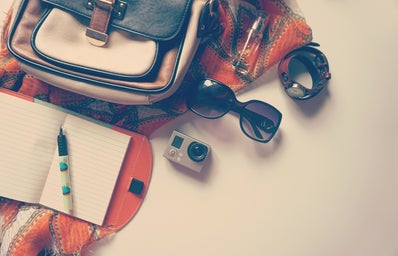Nowadays it seems like people have a lot of opinions about pockets. Or, to be more precise, people (especially women) are all of the same, very strong opinion that pockets in clothing designed for women are a problem. Whether they’re too small, deceptively fake, or simply nonexistent, women’s pockets are clearly made for no purpose other than decoration. Clothing designed for men, on the other hand, offers more pocket space, both in size and number, than most women can dream of. This double standard justifiably has people upset. To up-cycle a Freudian concept, the pocket envy is real and raging those of us who just want a convenient place to tuck away our cell phones.
It wasn’t always this way, either. Back in Medieval times, neither men nor women had pockets in their clothing. Instead, they carried around small bags that could be tied around their waists or attached to belts.
This system, however, meant that personal belongings, especially valuables, were left overly exposed to thieves who would slash purse strings and snatch bags right off peoples’ bodies. In response, people began to wear their bags under layers of clothing, with slits cut into the fabric so that their belongings would still be readily accessible.
By the 17th century, men’s clothing began to include pockets sewn directly into the fabric. Women’s clothing, however, retained the customary detachable pockets that could be hidden away under full dresses. To be fair, women still weren’t horribly disadvantaged (pocket-wise, at least) at this point. A woman’s detachable pocket could come in a variety of sizes and could hold things like money, jewelry, mirrors, a perfume bottle, combs, food, or even a bottle of gin. For wealthier women, these pockets became a canvas for more and more elaborate decorative embroidery. Sometimes pockets were even given as gifts.
The pivotal shift in the course of pocket history occurred in the 1790s when women’s fashion left behind wide hoop skirts and full petticoats for a neoclassical silhouette with high waistlines and skirts falling closely to the body. To ensure a clean line in the dress, pockets were nixed. To compensate, small pouches called reticules began to come into fashion, and were even later called “indispensables” because they were such a necessity for women. Reticules, precursors to the purse, were tiny, typically made out of mesh or netting, and closed with a drawstring. Reticules shaped like pineapples were particularly popular.
Despite their usefulness and popularity, reticules experienced some pushback. Because pockets used to be worn under dresses, some older, more traditional women criticized younger generations for using reticules because to them it was akin to wearing undergarments over their street clothes. For a while, reticules were also seen as too masculine because they allowed women to carry money and other belongings outside their dress, something that used to be reserved for men. Women who carried larger reticules were especially looked down on for being working women who didn’t have a man to provide everything for her like a wealthier woman would. In a way, though, these working women may have been slightly more independent than their wealthier contemporaries because they didn’t need to rely on a man to carry all her money.
Around the mid to late 1800s, if a woman wanted to be seen as independent she would look for skirts that had pockets sewn into them. And, a few decades later, women began wearing pants. Pants were particularly popular during the two World Wars, when they needed more utilitarian clothing to work while their fathers, husbands, brothers, and sons were off fighting. Post-war, however, pockets were stripped from women’s pants in an effort to make their silhouettes slimmer and pants more suitably feminine.
Perhaps the most recent, significant fashion change (and setback for pocket equality) occurred in the 90s, with the rise in popularity of luxury handbags. To state the obvious, if a woman carries a handbag, there’s technically no need for her to have functional pockets because she can store everything she needs in the bag. Fashion designers recognize this, and so feel free to design garments that don’t consider the usefulness of pockets.
Throughout all these fluctuations—the presence, the variations, and especially the absence of pockets—men have been able to continue taking for granted their pocketed attire. In 1954, the world famous designer Christin Dior said it best, “Men have pockets to keep things in, women for decoration.”
As I was writing this article, I talked over the problem of pockets with a male friend with a penchant for tight jeans. He pointed out that even though his pants are skin-tight, he still has deep pockets in which he feels comfortable keeping his iPhone. It’s not a problem of inability to fit pockets into women’s clothing, but an unwillingness to provide women with the same functional privileges as men for the sake of cutting a pleasing figure.
Resources: Racked, Vam, Mic, The Atlantic, The Dreamstress, Spectator

